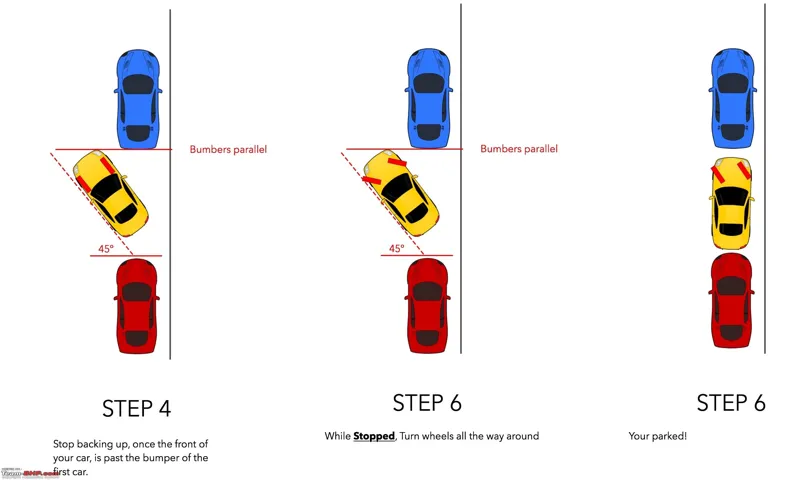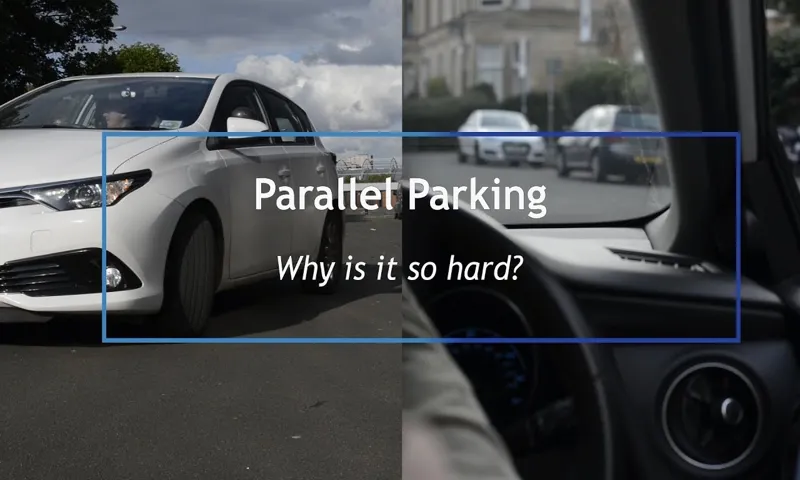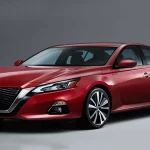If there’s one part of the driver’s test that strikes fear into the hearts of new drivers everywhere, it’s parallel parking. The mere thought of backing up into a tight space between two cars can cause sweaty palms and nervous jitters, but is parallel parking really as hard as it seems? In this blog post, we’ll explore the ins and outs of parallel parking, from the basic steps to tips and tricks for making it easier. Whether you’re a seasoned driver looking to brush up on your skills or a novice just starting out, read on to learn everything you need to know about this sometimes daunting driving maneuver.
Table of Contents
Understanding Parallel Parking
Parallel parking can be a daunting task for many drivers. It involves maneuvering your vehicle backward into a tight space between two parked cars. While it may seem like an impossible feat, with a little practice and patience, anyone can master it.
To start, make sure the space is big enough for your car and take it slow. Begin by lining up your car with the car in front of the parking space, then shift into reverse and start backing up slowly. As you approach the car behind the space, carefully turn your wheel to the right or left, depending on which side the parking space is on.
Keep a close eye on your mirrors and adjust as needed. Once you’re in the spot, straighten out your wheels and you’re done! While parallel parking may take some practice, once you master it, you’ll feel more confident and accomplished as a driver. So, don’t be discouraged, give it a try and soon you’ll be parking like a pro!
Why people find it difficult
Parallel parking is something that many people struggle with. Whether it’s nerves or lack of experience, it can be a daunting task even for experienced drivers. One reason why people find it difficult is that it requires a lot of practice and spatial awareness.
You need to be precise with your movements and make sure you don’t hit anything around you. It can be especially challenging when you’re driving a larger vehicle or when the spaces are limited. Furthermore, some people have difficulty judging distances and angles, and this can also make it more challenging to park in tight spots.
However, with enough patience and practice, anyone can learn how to parallel park like a pro. Remember to take it slow and don’t be afraid to ask for guidance if you need it. With time, you’ll become more confident and parallel parking will become second nature.

Environmental factors that impact parallel parking
Parallel parking can be a daunting task for many drivers, especially those new to driving or living in urban areas where parking space is limited. Environmental factors can have a significant impact on the difficulty of parallel parking. One of the most important factors is the size of the parking space.
Smaller parking spaces require more precise maneuvers, making parallel parking more difficult. Another factor to consider is the slope of the road. Parking on a sloped road can make it challenging to park parallel to the curb.
Other environmental factors include the presence of obstacles such as trees, poles, or other parked cars, which can restrict maneuvering space. Additionally, weather conditions such as rain, snow, or ice can make parallel parking more challenging, reducing traction and visibility. By understanding the environmental factors that impact parallel parking, drivers can better prepare themselves and execute the maneuver more safely and efficiently.
Tips to make it easier
Is parallel parking hard? For many, the mere thought of parallel parking can often lead to feelings of dread and anxiety. However, with a bit of practice and these helpful tips, parallel parking can become a breeze. First, make sure to properly align your car with the vehicle in front of the empty parking space.
Then, begin reversing towards the space while turning your steering wheel. As you approach the curb, straighten out your wheels and move forward to center yourself in the space. Remember to take your time and use your mirrors to ensure you maintain a safe distance from other vehicles.
If you find yourself struggling, it may be helpful to find an empty parking lot and practice until you feel more confident. With a little patience and persistence, parallel parking can be easily mastered. So, the answer to the question “Is parallel parking hard?” is no, not if you practice and follow these simple steps.
Finding the right spot
Finding the perfect spot for anything can be tough, whether it be a new house, a new restaurant or even a new plant in your home. But when it comes to finding the right spot for your new plant, there are a few things to keep in mind to make the process a little less daunting. Firstly, think about the light in your home and choose a spot that will provide enough sun for your plant’s specific needs.
It’s also important to consider the temperature and humidity of the room, as some plants require more moisture than others. Don’t forget about space either – if your plant is going to grow, it’s important to ensure there’s enough room for it to do so without it becoming cramped. By taking these factors into consideration, you’ll be well on your way to finding the perfect spot for your new plant to thrive in your home.
Preparing for the maneuver
If you’re preparing for a maneuver, there are a few tips that can make the process much easier. First, it’s important to make sure that you have a clear understanding of what the maneuver entails. This might involve reviewing diagrams or videos, or even practicing in a simulator if one is available.
Additionally, you’ll want to make sure that you have all of the necessary equipment and supplies on-hand before you begin. This could include things like safety gear, tools, or special instruments. Finally, it’s essential to stay focused and calm throughout the maneuver.
Avoid distractions and try to maintain a clear head, even if things don’t go exactly as planned. By following these simple tips, you can ensure that you’re fully prepared to successfully execute any maneuver that you need to perform.
Executing the maneuver
When it comes to executing a maneuver, it can be a bit nerve-wracking. But with a few tips, you can make it easier. First, make sure you have practiced the maneuver beforehand and know what to expect.
This can alleviate anxiety and help you react more quickly if anything unexpected happens. Second, keep your focus on the task at hand and avoid distractions, such as checking your phone or talking to passengers. Third, trust in the capabilities of your vehicle and yourself.
Remember that you have trained for this and have the skills necessary to execute the maneuver successfully. By following these tips and keeping a clear head, you can execute any maneuver with confidence and ease.
Common mistakes to avoid
Many people ask themselves the question “is parallel parking hard?” and for some, the idea of angling their car perfectly into a tight spot can cause anxiety. However, with the right practice and some common mistakes to avoid, parallel parking becomes less daunting over time. The most common mistake is not leaving enough space between your car and the car in front of you.
This will make it difficult to fully turn your tires and maneuver your way into the spot. Another mistake to avoid is not using your mirrors and relying solely on your rearview camera. While these cameras can be helpful, they don’t always show the full picture of what’s going on around you.
Lastly, one of the most important tips is to take your time and not rush the process. By being patient and calm, you’ll be able to parallel park with ease!
Misjudging distance and space
Misjudging distance and space on the road can be quite dangerous and lead to accidents. One of the common mistakes people make is assuming they have more space than they actually do. Sometimes, when driving on narrow roads or parking lots, we tend to overlook the proximity of other cars, curbs, or objects, such as poles or walls.
This can lead to dents, scratches, or even more serious damage to the vehicle. Another common error is underestimating how long it takes to stop the car. This is particularly crucial when driving at high speeds or in wet or icy conditions.
Misjudging stopping distance can result in collisions or running off the road. It’s essential to always pay close attention to the road, keep a safe distance from other vehicles, and remain alert to your environment. By doing so, we can avoid misjudging distance and space and ensure our safety and that of others while on the road.
Failing to check surroundings
When it comes to driving, one of the most common mistakes people make is failing to check their surroundings. It’s all too easy to get caught up in the moment and focus solely on what’s happening on the road ahead. But taking your eyes off the road for just a few seconds can be all it takes to cause a serious accident.
It’s important to be aware of your surroundings at all times, including other cars, pedestrians, cyclists, and potential hazards like potholes or debris on the road. Remember, driving is not just about getting from point A to point B – it’s about doing so safely and responsibly. So always keep your eyes peeled and stay alert to what’s going on around you, even if it means taking a few extra seconds to do so.
By doing this, you’ll not only avoid accidents but also help keep yourself and others safe on the road.
Practice makes perfect
Many people find parallel parking to be a daunting task. It requires a lot of practice and concentration to perfect this skill. However, with practice, you can become a master at parallel parking.
The first step is to familiarize yourself with your car’s dimensions and turning radius. This will allow you to judge distances and angles better. You can then start by finding an empty space to practice in and using cones or other objects as markers.
Begin by pulling up beside the space and lining up your car’s back wheel with the front of the other car’s back wheel. Turn the steering wheel towards the curb and slowly reverse into the space. Use your mirrors and turn your head to check your surroundings constantly.
It’s important to take your time and perform the maneuver slowly, ensuring that you don’t hit any cars or objects. Once you’ve successfully parked, don’t forget to check your proximity to the curb and adjust if necessary. Remember, practice makes perfect, and the more you do it, the easier it becomes.
So, don’t give up, keep practicing, and soon enough you’ll be parallel parking like a pro!
Conclusion
After careful consideration and analysis, it is safe to say that parallel parking is indeed hard. But fear not, with practice and patience, anyone can master this essential driving skill. So next time you find yourself struggling to fit your car between two parked vehicles, just remember that it’s not you, it’s the parking space that’s being difficult.
“
FAQs
Why do some people find parallel parking difficult?
Parallel parking can be difficult for a variety of reasons, including a lack of practice, poor spatial awareness, and anxiety behind the wheel.
What are some tips for mastering parallel parking?
Some tips for successful parallel parking include practicing in low-stress areas, using your mirrors and backup camera, adjusting your seat position, and taking your time.
Is it easier to parallel park with a small or large car?
In general, smaller cars are easier to parallel park since they have a smaller turning radius and are more nimble in tight spaces. However, with practice, drivers of any size car can become proficient at parallel parking.
What are some common mistakes drivers make while parallel parking?
Common mistakes include misjudging the distance between your car and the other vehicles, turning the wheel too sharply, and hitting the curb.
How important is parallel parking for passing a driver’s test?
Parallel parking is typically a required component of a driver’s license exam, and a failed attempt can result in an automatic failure. Thus, it’s important to practice this skill before taking the test.
What if I have difficulty with parallel parking even after practicing?
If you are still struggling with parallel parking even after practice, consider taking a driving course or hiring a private driving instructor to help you improve your skills.
What are some common alternative parking options to parallel parking?
Some alternative parking options include diagonal parking, perpendicular parking, and pull-in parking. However, parallel parking is still a necessary skill to have in many urban areas where parking space is limited.



